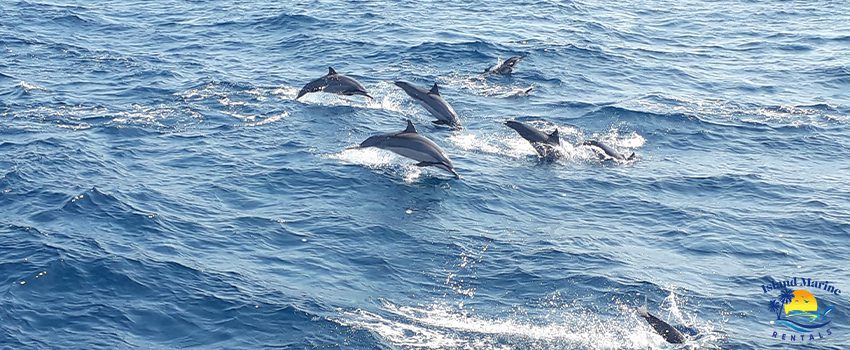If you’re planning to explore the waters surrounding Florida, the Gulf of Mexico is one the most visited by tourists. Aside from its panoramic view, it is home to thousands of species of ocean animals. While you’re sailing on the Gulf of Mexico, you might see them swimming or playing in the water.
To give you an idea about what species live on the gulf coast, here are some:
1. Dolphins
When boating on the Gulf of Mexico, dolphin sightings are not a rare occurrence.
Some species you might encounter include:
- Bottlenose Dolphins: These are dolphin species known for their short, thick snouts, hence the name. They are light gray, but their bellies are white, and their tops (the part near their dorsal fins) are almost black.
- Striped Dolphins: These dolphins have small- to medium-sized, sleek, robust bodies and round foreheads. Males can reach up to nine feet in length, while females can reach eight. Unlike bottlenose dolphins, these have long snouts.
- Fraser’s Dolphins: These dolphins have small, distinct snouts and stocky bodies. Their dorsal fins have a small, triangular shape and are located midway down their backs. Males have more distinct patterns compared to females.
- Clymene Dolphins: These dolphins are easy to identify since they have a unique, three-part color pattern. They have dark gray backs, pale gray or white undersides, and light gray sides.
- Spinner Dolphins: These dolphins are known for their acrobatics. They love to jump as well as spin and flip above the water. Their name comes from their ability to spin multiple times in a single leap.
- Orcas: Killer whales or orcas are also part of the dolphin family. There’s only a small population of them on the gulf coast, which makes seeing them a rare occurrence.
2. Manatees
Among the ocean animals you might see while boating on the Gulf of Mexico are the majestic manatees. They are cow-like creatures that eat more than 60 species of floating, shoreline, and underwater plants. Manatees are herbivores, and their diet mainly consists of seagrass.
They never leave the water, but they need to inhale air every five minutes. They were considered endangered but not anymore thanks to the Endangered Species Act and Marine Mammal Protection Act. There’s only one species of manatee on the gulf coast — the West Indian Manatee.
3. Whales
The Gulf of Mexico is also home to different whale species, including:
- Blue Whales: These are large marine mammals with a blue-gray color. They live on the gulf coast, so sighting them is possible but rare.
- Bryde’s Whales: There are only more than 50 of these whales in the northern Gulf of Mexico. They have sleek bodies, three prominent ridges, and pointed, slender flippers.
- Fin Whales: Fin whales have streamlined bodies and V-shaped heads. They have distinct colorations that include white undersides and dark-brownish gray or black on the sides and back.
- Other Whale Species: The other whale species that also live on the gulf coast include minke whales, humpback whales, sperm whales, and northern right whales.
4. Sharks
There are a few shark species on the gulf coast, and they include:
- Blacktip Sharks: These sharks are common in the Gulf of Mexico. They have fusiform, stout bodies, and their dorsal fins have black tips. They don’t pose serious threats, but they have had 11 unprovoked bites on humans since 1959.
- Lemon Sharks: These have yellow, brown, or olive-gray color on their dorsal surfaces and pale yellowish-white undersides. Lemon sharks pose little threat to humans, and there are only 10 unprovoked attacks recorded in history. All of which are in Florida and the Caribbean.
- Tiger Sharks: Tiger sharks have the fourth largest population among other shark species in the Gulf of Mexico. Along with the bull and great white sharks, they are considered as one of the most dangerous sharks around the world.
- Bull Sharks: Bull sharks are one of the most common sharks in the Gulf of Mexico. They are medium-sized sharks with stout, thick bodies and long pectoral fins.
5. Horseshoe Crabs
Horseshoe crabs are considered living fossils. They have existed for 445 million years now, making them even older than dinosaurs. Horseshoe crabs are a common sight on beaches along the Gulf of Mexico. They have hard shells, segmented bodies, and ten eyes. You’ll be amazed at the way they move and at how quickly they can hide under the sand.
6. Sea Turtles
Year after year, sea turtles come back to lay their eggs on beaches along the gulf coast. Records show that five out of seven sea turtle species swim in the gulf waters.
The five species are the following:
- Hawksbill Sea Turtle: Hawksbill sea turtles got their name from their hawk-like beaks. They are usually found on the reefs of the southern gulf coast.
- Green Sea Turtles: Green sea turtles are among the largest sea turtle species and are the only ones known to be herbivores.
- Loggerhead Sea Turtles: Loggerhead sea turtles are the most common species and are widespread in the U.S.
- Kemp’s Ridley Sea Turtles: Kemp’s ridley sea turtles are the smallest among all species. They are endangered and are primarily found in the Gulf of Mexico.
- Leatherback Sea Turtles: Leatherback sea turtles, as the name implies, have rubbery, flexible shells that differentiate them from other species. They are the largest among all species and can grow up to seven feet.
The Best Boat Rental on the Gulf of Mexico
To make the most out of your vacation in Florida, look no further than Island Marine Rentals.
If you’re looking for the best boats for cruising the Florida Gulf Coast, we offer a wide array to choose from — pontoon, hurricane deck, and bowrider boats. Safety is our priority, which is why we have been voted as the best boat rental provider by Tripadvisor for eight consecutive years. We offer boat rental services in Indian Rocks Beach, FL, and other nearby areas. Call us today for schedules and reservations!


